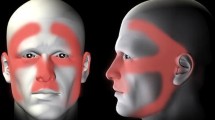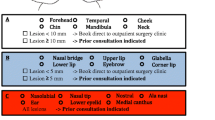Abstract
Facial lesions are commonly referred to ear, nose and throat surgeons. Almost all are amenable to excision under local anaesthetic as a day case. However, in the UK, there is still a significant delay between referral by the general practitioner (GP) and final surgery. To address this delay, a one stop see and treat consultant led clinic was set up in the community. The aim of this study was to assess the impact of the one stop clinic on waiting times and to ascertain the satisfaction of patients with the treatment they received in this clinic. Patients with facial skin lesions were referred by the GPs to the ENT department in the usual manner. The referral letters were screened by two consultants, the appointments were booked by telephone and the patients were seen and treated in a single visit. The clinics were held in a minor surgery unit of a centrally located GP practice. Patients were seen, assessed and if the facial lesion was considered amenable to excision under local anaesthetic, the patient was consented and the procedures carried out immediately. The clinic was audited over a 1 year period. Waiting times were compared before and after the start of the project. Patients were asked to fill in a questionnaire immediately after surgery. The attendance rate was 96%. The waiting time was reduced from 121 to 47 days. Patients rated the clinic experience as excellent (88%) or good (12%) indicating a very high satisfaction rate. During the study period, 160 lesions were excised of which 22% were malignant. Patients with malignant lesions did not show any sign of recurrence at a follow up of 9 months, except in one case with basal cell carcinoma. This was operated on and removed completely. Our project shows that the aims of reducing waiting times and improving patient care were achieved with this community model of a one stop facial lesions clinic. This clinic is now an integral part of the service provided by the ear, nose and throat department at Ipswich hospital, UK.

Similar content being viewed by others
References
Ahmad I, Das Gupta AR (2001) Epidemiology of basal cell carcinoma and squamous cell carcinoma of the pinna. J Laryngol Otol 115:85–86
Avril MF, Auperin A, Margulis A, Gerbaulet A, Duvillard P, Benhamou E, Guillaume JC, Chalon R, Petit JY, Sancho-Garnier H, Prade M, Bouzy J, Chassagne D (1997) Basal cell carcinoma of the face: surgery or radiotherapy? Results of a randomized study. Br J Cancer 76:100–106
Cancer Research UK (1999) Incidence of cancer
Department of Health (2000) The NHS plan: a plan for investment, a plan for reform
Dieu T, Macleod AM (2002) Incomplete excision of basal cell carcinomas: a retrospective audit. ANZ J Surg 72:219–221
Franceschi S, Levi F, Randimbison L, La Vecchia C (1996) Site distribution of different types of skin cancer: new aetiological clues. Int J Cancer 67:24–28
Hallock GG, Lutz DA (2001) A prospective study of the accuracy of the surgeon’s diagnosis and significance of positive margins in nonmelanoma skin cancers. Plast Reconstr Surg 107:942–947
Hannuksela-Svahn A, Pukkala E, Karvonen J (1999) Basal cell skin carcinoma and other nonmelanoma skin cancers in Finland from 1956 through 1995. Arch Dermatol 135:781–786
Kirkup ME, De Berker DA (1999) Clinical measurement of dimensions of basal cell carcinoma: effect of waiting for elective surgery. Br J Dermatol 141:876–879
Lalloo MT, Sood S (2000) Head and neck basal cell carcinoma: treatment using a 2-mm clinical excision margin. Clin Otolaryngol 25:370–373
Lathlean S (1999) Skin cancer in general practice in South Australia. A 5 year study. Aust Fam Physician 28(Suppl 1):S28–S31
Martinez JC, Otley CC (2001) The management of melanoma and nonmelanoma skin cancer: a review for the primary care physician. Mayo Clin Proc 76:1253–1265
Petit JY, Avril MF, Margulis A, Chassagne D, Gerbaulet A, Duvillard P, Auperin A, Rietjens M (2000) Evaluation of cosmetic results of a randomized trial comparing surgery and radiotherapy in the treatment of basal cell carcinoma of the face. Plast Reconstr Surg 105:2544–2551
Author information
Authors and Affiliations
Corresponding author
Appendix
Appendix
Patient questionnaire for one stop see and treat clinic for facial lesions.
Survey results (total respondents 158) | |||||
Yes | No | ||||
Q1 | Did your GP explain to you the reason for your referral | 153 | 5 | ||
Q2 | Did you receive enough information about the appointment | 151 | 7 | ||
Q3 | Was the appointment time convenient for you | 147 | 11 | ||
Q4 | Did you have any problems getting to the clinic today | 15 | 143 | ||
Q5 | Did the hospital change your appointment at any time | 27 | 131 | ||
Q6 | Was the diagnosis and treatment fully explained | 154 | 4 | ||
Q7 | Were you given enough time to ask questions | 156 | 2 | ||
Q8 | How would you rate your overall experience of the clinic today | Bad | Average | Good | Excellent |
0 | 0 | 19 | 139 | ||
Rights and permissions
About this article
Cite this article
Salam, M.A., Matai, V., Salhab, M. et al. The facial skin lesions “see and treat” clinic: a prospective study. Eur Arch Otorhinolaryngol 263, 764–766 (2006). https://doi.org/10.1007/s00405-006-0058-2
Received:
Accepted:
Published:
Issue Date:
DOI: https://doi.org/10.1007/s00405-006-0058-2




